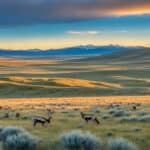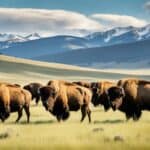Could America’s deserts now hide wild camels, left from a 19th-century test? The idea of camels in the US sounds like a dream but points to real history. Stories like the Red Ghost of Arizona are intriguing. They show more about America’s past than its today.
A project from the past brought camels to parts of the US. Since the early 20th century, evidence of these camels has faded. Now, they’re part of stories, maybe true, maybe not. Do wild camels really still live in the US deserts today?
The History of Camels in the United States
The story of camels in the United States is quite interesting. It starts with a bold experiment to use these tough animals in the West. This was a unique effort in American history.
The Introduction of Camels in 1856
In 1856, Secretary of War Jefferson Davis brought camels to the U.S. He thought they could change how things were moved across the deserts. The camels first reached Indianola, Texas. From there, they kicked off a big change in U.S. transportation history.
The Role of the U.S. Army and Jefferson Davis
Jefferson Davis saw the big picture for the U.S. with this U.S. Army camel experiment. He saw how valuable the camels could be. They were perfect for carrying loads over tough lands. He believed they would become key in the military and help the settlers too. These camels were set to be vital in exploring the wild West of America.
The Camel Corps Experiment
The Camel Corps experiment was a daring venture in American military history. Its goal was to use camels’ special skills in tough terrains. Captain Major Henry C. Wayne took the lead in this new approach.
Major Henry C. Wayne’s Missions
Major Wayne wanted to fix the U.S. Army’s issue of moving things in dry areas. He led efforts to see if camels could help with this. He tested how tough and useful camels were under his watch.
Wayne was in charge of getting and looking after camels. He put them to work in Texas and other harsh places. They did well, showing they were great at carrying heavy stuff far.
The Success of Camels as Pack Animals
The experiment with camels went better than expected. These animals turned out to be faster and stronger than mules and horses. They were really good at moving through dry lands.
But, even with their clear talent, the Camel Corps hit big challenges. Wayne and his team couldn’t overcome them. Yet, they proved that camels were up for the task, showing a new way for the army to think about moving supplies.
Are there wild camels in the USA?
Once, wild camels were known to roam the Southwest after the Civil War. This happened because some animals got loose or were let go. But today, it’s very rare, if not impossible, to see a wild camel in the USA. In the late 1800s and early 1900s, people did spot these animals. But over time, these sightings have become more of a tale, weaving itself into folklore and legend.
American wild camels used to be spotted in the wide-open deserts. While there are still reports or stories about them, there’s no solid proof of their existence now. The stories of these wild animals are fading away. They’re becoming part of the past, still sparking interest in those who love history and adventure.
The Red Ghost Legend
The Red Ghost is a chilling tale from Arizona’s camel folklore. It tells of a camel with a human body on its back, soaked in blood. This beast scared people in the late 1800s.
The Sightings and Stories
Many claimed they saw the Red Ghost, adding truth to the rumors. People told of horrible run-ins, saying it looked terrifying and acted violently. The most frightening story tells of the Red Ghost killing a woman with a step, leaving everyone in shock.
The Impact of the Red Ghost on Local Communities
This tale deeply affected local folks, spreading fear and wonder. It all started with a story about a dead red-haired camel found with human evidence. The Red Ghost story likely came from the history of the Camel Corps. Even with some hints, the legend lives on, adding spooky notes to the Wild West tales.
Post-Civil War: The Fate of Released Camels
After the Civil War, the future of camels in the USA became uncertain. The Camel Corps ended, leaving these tough animals without a clear path. Many of them were sold to circuses and zoos. This move entertained and educated the public.
Others got a job in Nevada’s mining towns. These camels were valued for their power and stamina. They hauled heavy loads over tough ground with ease.
The camels at Fort Tejon faced a different future. They ended up being sold to private owners. Edward Fitzgerald Beale was one of them. He was famous for using camels to cross dry lands.
It’s interesting that some camels got away or were set free on purpose. People recorded many sightings in the Southwest. These feral camels quickly adapted to living in the wild. They thrived until the early 1900s.
| Post-Civil War Outcomes | Details |
|---|---|
| Sold to Circuses and Zoos | Provided entertainment and educational displays. |
| Freight Operations | Employed in Nevada mining towns for transportation. |
| Private Ownership | Sold to individuals like Edward Fitzgerald Beale. |
| Feral Population | Some camels escaped or were freed, leading to sightings in the Southwest. |
The story of camels in the USA after the Civil War is truly interesting. These animals found their way into many parts of American life. The memory of these camels continues through history and stories told by locals.
American Wild Camels: Facts and Myths
The tale of American wild camels is a fascinating blend of documented encounters and myth. It’s crucial to tell the difference between what really happened and what might be just stories.
Confirmed Sightings in the Late 19th and Early 20th Centuries
In the late 1800s, notable sightings of wild camels were seen. For example, in 1887, two were spotted south of the Mexican border. Another incident was in 1929, where a camel stampede was reported in Banning, California. These accounts help build the history of wild camels in America.
Debunking Popular Myths
However, many myths about American wild camels continue. Stories of these camels have been blown out of proportion over the years. While it’s true they once lived in the U.S. Southwest, their numbers fell as time passed, and the myths grew bigger.
It’s important to know what’s real and what’s not. This way, we can truly understand the story of American wild camels.
Camel Sightings in the USA Today
Today, finding wild camels in the USA is more dream than reality. The days of the Camel Corps are long gone. But, if you love history, you might visit places in Arizona, California, and Texas. These areas were once traveled by camels. You can enjoy the historical journey and, who knows, maybe see a wild camel’s descendant.
Where to Spot Remnants of the Camel Experiment
For history lovers or the curious, there are special spots to explore the Camel Corps’ legacy. These places are rich in stories of the past:
- Arizona: With tales like the Red Ghost, Arizona’s deserts whisper the Camel Corps’ secrets.
- California: Places like Fort Tejon hold the history of the U.S. Army’s camel story.
- Texas: Texas was the first stop for the camels, marking an important chapter in their history.
Even though wild camels aren’t found in the USA anymore, their story lives on. It connects us to a mysterious and adventurous past. Exploring these regions lets you step back in time and imagine the Camel Corps’ daring days.
The Role of Camels in the Southwestern U.S.
Camels had a big job in the Southwestern U.S. They were used in the military and for work.
Military Uses and Beyond
Camels were first brought to the Southwestern U.S. for the army. Their strength and toughness were perfect for carrying supplies in the desert. They were better than other animals at this job. Even though their role in the military decreased over time, they are still a key part of the Southwestern U.S. history.
Camels in Mining and Transportation
In addition to the military, camels were a huge help in mining. They could carry heavy loads, which was crucial for moving ore in the mining areas. This was especially true in places that were hard to reach. Camels also helped build things like the transcontinental railroad by moving materials. They played a key part in these big projects.
“Camels have been an integral part of our mining history, bearing the burdens of a growing industry and helping transport heavy loads across challenging terrains,” says a local historian.
| Aspect | Role of Camels |
|---|---|
| Military Operations | Transportation of supplies, enduring harsh terrains |
| Mining Industry | Transporting ore and materials in remote areas |
| Infrastructure Projects | Assisting in the construction of transportation networks |
Wild Camel Habitat in North America
The dry deserts in the Southwestern U.S. are a key part of *wild camel habitat USA*’s story. These places, like Texas, Arizona, and California, are much like the Middle East. In the mid-19th century, they became a safe place for camels.
Camels in North America show amazing toughness. They made do in sandy and rocky areas. Camels found what they needed to do well, just like American pioneers.
These camels were meant for the military at first. But they soon became a part of the local tales. They turned from working animals to heroes in stories.
The *wild camel habitat USA* in the Southwest was tough but doable. It was a challenge, but the camels showed their strength. Their time here added a unique chapter to North America’s story.
The Significance of Camels in American History
Camels hold an important place in American history. They are more than just unusual beasts. They were part of a key moment in military history. This episode mixes military innovation with great stories.

Contribution to Military Expeditions
In the American Southwest, camels were vital for the military. They could survive hot deserts and carry heavy loads. Thanks to this, the U.S. Army used them a lot. Major Henry C. Wayne showed that camels could change how we do logistics in wars. They made tough tasks doable.
Cultural Impact and Folklore
Camels have left a big mark on the cultural side of American history. They brought something unique and unforgettable. The story of the Red Ghost in Arizona is just one example that became part of local myths. It shows how they fit into the culture of their time.
This part of history is a mix of real accomplishments and amazing stories. It’s a symbol of how America has many different chapters in its story. Plus, it shows how cultures can meet and influence each other.
The Long-Term Impact of the Camel Experiment
The camel experiment in the U.S. didn’t just try something new. It showed us how bold ideas shape history, even when they fail. It was meant to help in the harsh lands of the Southwest but fell short for war. The experiment did show us how curious humans can be and highlighted the camels’ strong points.
This story gave us more than just a failed military plan. Camels are now part of American stories and myth. The Red Ghost tale is one example. It’s now woven into American frontier stories. This experiment leaves us with a lesson. Big ideas, even when they miss the mark, make their mark on history.
The camel experiment also changed local areas and the people living there. The camels in the U.S. impacted the environment and became part of its story. Their footprints can still be seen today. This experiment reminds us of the many stories in American history. It shows how curiosity and big ideas shape our world.
FAQ
Are there wild camels in the USA?
The idea of wild camels in the USA is mostly from the 19th century. Then, some camels went feral. But now, seeing wild camels is very rare.
How did camels get introduced to the United States?
The U.S. brought camels over in 1856 for a military test. This project was to help the country expand to the west.
What was the purpose of the Camel Corps experiment?
This project was to see if camels could carry heavy loads in the desert. Camels were thought to be better than mules or horses for this job.
Is it true that camels once roamed freely in North America?
Yes, after the Civil War, some of these camels got loose. They wandered the Southwest until the early 20th century.
What is the legend of the Red Ghost?
The Red Ghost is a spooky tale from Arizona. It’s about a red camel with a dead person on its back. This story became part of local myths because of strange sightings.
What happened to the camels after the Camel Corps was disbanded post-Civil War?
After the war, some camels were sold to circuses and zoos. Others helped with mining work. A few ran off and lived in the wild for a short time.
Are there any confirmed sightings of wild camels in the USA today?
Today, there is no proof of wild camels living in the USA. Stories about them mostly come from folklore and myths, not facts.
Where might one spot remnants of the Camel Corps experiment?
You can find clues to the camel story in Arizona, California, and Texas. These areas were once home to these unusual animals. Maybe a few are still out there.
What roles did camels play in the Southwestern United States?
In addition to the military, camels helped with mining and building railroads. They had more jobs than just carrying things in the desert.
What type of habitat did the wild camels inhabit in North America?
The dry deserts of Texas, Arizona, and California were perfect for these camels. This was because the places reminded them of their original home.
How significant were camels in American history?
Camels made a big but short difference in the U.S. They helped the military and left behind some unusual stories. Their time in America left a mark.
What was the long-term impact of the camel experiment in the USA?
This experiment changed the land and the people in the West. It also left a story that still interests people today. The camels’ tale lives on through history and stories.







